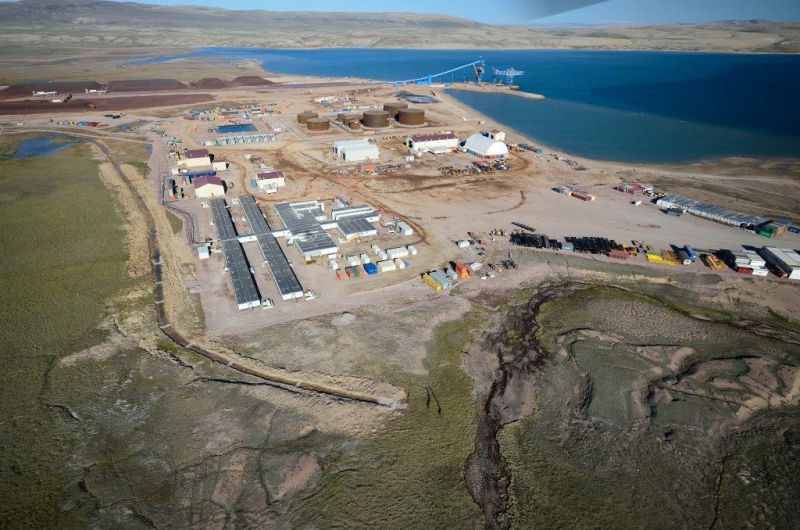Plans to build Canada’s first Arctic railway take a big step forward
Baffinland Iron Mines Corp. has submitted an environmental impact statement for a plan to build a rail link to the company's Mary River iron ore mine.

A plan to nearly triple iron ore production at the Mary River mine on north Baffin by building Canada’s first Arctic railway took a big step forward last week, when Baffinland Iron Mines Corp. submitted an environmental impact statement for the project to the Nunavut Impact Review Board and the Nunavut Water Board.
That move will likely kickstart a lengthy period of consultation and scrutiny involving affected communities, Inuit organizations, government departments and other players, likely culminating in a public hearing.
The EIS report represents “a significant milestone” in developing the company’s expansion plan, Brian Penney, Baffinland’s president and CEO, said on Aug. 14 in the announcement.
And it may be the first step in an even bigger future expansion. The company has not given up on the idea of a southern railway route to Steensby Inlet, which it’s permitted to build under its 2012 project certificate.
“The expansion represents the first step of Baffinland’s larger expansion program, which also includes the previously approved construction of a railway from the Mary River Mine, travelling south to Steensby Inlet,” the announcement said.
But first, the review board must look at Baffinland’s EIS submission — which is actually an “addendum” to Mary River’s existing final EIS — to ensure it conforms to guidelines.
Since 2014, Baffinland has sought permission to expand annual iron ore production at Mary River from 4.2 million metric tonnes to 12 million metric tonnes.
To haul that ore to its port at Milne Inlet, Baffinland would build a 110-kilometer (about 68-mile) railway from Mary River to replace an existing tote road.
At the same time, its fleet of haul trucks would be replaced by five diesel-powered locomotive engines and 176 ore-carrying rail cars.
The ore would be stockpiled at Milne Inlet and — in the ice-free season — shipped to market on ore-carrying vessels.
Penney said last February that Baffinland needs the expansion to become financially viable.
The privately held company, co-owned on a 50-50 basis by Nunavut Iron Ore and ArcelorMittal, has yet to make any money.
“Baffinland did not pay any corporate income tax in 2017 as the company is not yet profitable,” the company said in a socio-economic monitoring report released this past March 31.
A similar report for 2016 said Baffinland didn’t make any money that year either.
According to the commodity price aggregator site, Index Mundi, the spot price of iron ore stood at only US$66.10 per metric tonne this past May, a nearly 50 per cent drop from 2013 prices.
But the company says if it’s allowed to increase production volumes to 12 million tonnes a year, they’ll be insulated in the future from low iron ore prices.
“When we expand to 12 million tonnes a year, our unit cost would decrease by half,” Penney told a business audience attending the Northern Lights trade show in Ottawa last February.
The company did, however, pay nearly $1.5 million in employee payroll tax to the Government of Nunavut in 2017, and in 2016 made about $1.1 million in payroll tax remittances to the GN.
Baffinland also paid about $3.2 million to the Qikiqtani Inuit Association in land-lease payments and other fees during the QIA’s 2017-18 fiscal year, the QIA’s last annual report states.
Baffinland has also paid many millions more in royalties to the QIA, including $7.3 million in previously unpaid royalties that an arbitration panel ordered the company to cough up last year.
For that reason, the company says expansion of ore production would increase the benefits it distributes to QIA and others in the region.
“The expansion of the Mary River mine is critical to the long-term viability of our operation, and the key to bring enhanced benefits to the North Baffin communities and our partners,” Penney said.
Despite a flurry of opposition last year from a group in Pond Inlet, the Nunavut Planning Commission quietly agreed last March to amend the North Baffin Regional Land Use Plan to allow a railway between Mary River and Milne Inlet.
By early May, Nunavut Tunngavik Inc., the GN and the federal government had all said yes — in an equally quiet manner, with no announcements — to the planning commission’s railway recommendation.
This means that after nearly four years, Baffinland’s expansion plan is now able to move to the review board for an actual environmental assessment.
In the meantime, the Nunavut review board is also looking at a smaller application from Baffinland: for permission to increase annual shipments from 4.2 million metric tonnes a year to 5.5 million metric tonnes in 2018 and six million metric tonnes in 2019.
That would involve changing two terms and conditions contained in the mine’s existing project certificate.
As for the expansion plan proposal, the company hopes the review board and the water board can study it at the same time to speed up the permitting process.
The environmental assessment statement for Baffinland’s expansion plan has not yet appeared on the review board’s public registry.